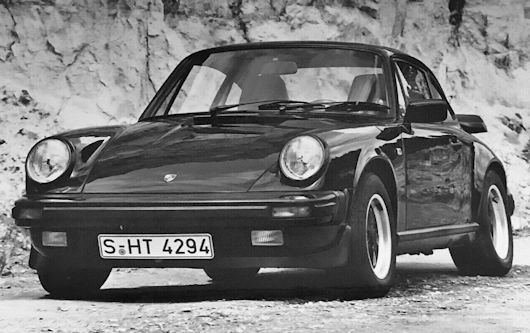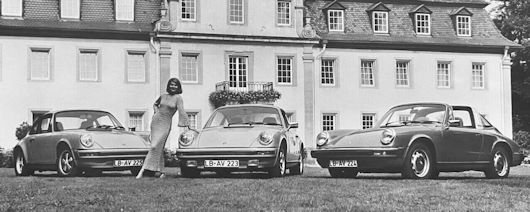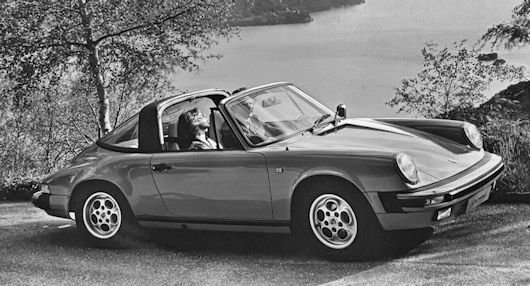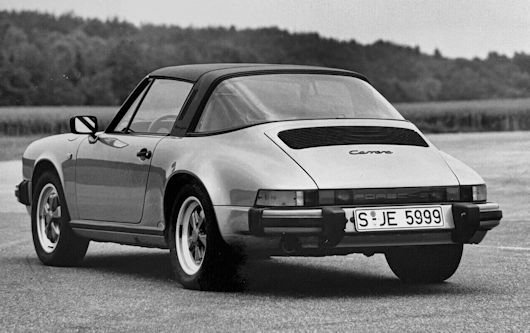Warning
Porsche 911 2nd Generation "G"
 | |
Production period: | 1973 to 1989 |
great: | Sports car |
Body versions: | Coupe, Cabriolet, Roadster |
Motors: | Boxer engines:2.7– 3.3 litres |
Length: | 4291 mm |
Width: | 1652 mm |
Height: | 1310 mm |
Wheelbase: | 2211 – 2272 mm |
Empty weight: | 1080 – 1335 kg |
The Porsche 911 is a Sports car and the successor of the previous Porsche 356 model. The Porsche 911 is the most famous vehicle of the Stuttgart Company and is considered the epitome of brand. The first major revision of the 911 body was made in 1972 by the US Road Safety Authority (NHTSA) enacted regulation necessary. The Motor Vehicle Information Act now required for all new vehicles that the bumpers impact an obstacle up to a speed of 5 mph does not result in any damage to the car. To meet this requirement, the 911s were equipped with newly designed bumpers, which were equipped with integrated elastic impact dampers for the US market. Favourable baffles were used for all vehicles that were not intended for export to the USA, but these deformed during park brakes and therefore had to be replaced. The baffle dampers could be ordered as an extra.
Each model year of the 911 is referred to internally as a letter. The census began in mid-1967 with the model year 1968 as A-series and ended with the model year 1979 as an M series (letter I was not awarded). The models from 1980 are called program designated: Model year (Mj.) 1980 as A program up to Mj. 2000, the Y program. The letters I, O, U and Q were not used. Mj. 2001 is the 1 program, Mj. 2002 the 2 program etc. From model year 2010 (A program) the alphabet is used again.
The G series of the Porsche 911 original model appeared in mid-1973 (model year 1974). As a G model it became the second generation of the total eight model generations of the Porsche 911 (As of 2022). The G-model was manufactured for a total of 16 years until mid-1989 (end of K program). With the K program from mid-1988, production of the third generation of the Porsche 911 started at the same time: the Porsche 964.

Body types
The main difference between the original model and the G-model are the large bumpers of the newer 911, which are more massive. Above all, the fold-like plastic transitions between the bumpers and the body.The front flashing lights were moved from the fender to the bumper. A continuous red reflector belt with the inscription „Porsche “has been added to the rear of the rear lights. More sporty models, such as B. the Carrera or the Turbo, have fenders on the front and especially at the rear in order to be able to pick up wider wheels. Other differences on the body to the original model, such as B. the further enlarged wheelbase is hardly visible optically.
The car was initially offered in the equipment variants 911, S and Carrera. With a wider body, the new one was launched in early 1975 (H series) 911 turbo delivered. The 3 Liter engine with turbocharger of the then fastest German production car produces 260 hp and enables a top speed of 250 km / h. From model year 1978 it is with Charge air cooler and 3.3 Liters displacement even 300 HP for 260 km / h top.
From model year 1976, Porsche used a hot-dip galvanized body on both sides. Porsche was therefore able to offer a six-year guarantee against rusting, which was extended to seven, later even ten years for the model year 1981.
The 911 G model was initially only as Coupe and Targa available. The security laws in preparation in the United States Cabriolets had refused US approval were finally rejected in the early 1980s. After a break of almost 20 years, Porsche therefore placed on the Geneva Motor Show with the 911 SC Cabriolet again an open vehicle. Of the 4,277 SC cabriolets built in the first model year in 1983, over 40% (1,877 vehicles) went to the USA. The 911 Speedster with emergency roof presented as a study at the IAA in Frankfurt in 1987 was in the model year Built in 1989 as a small series 2102 times.
Engine
From 1974, all 911 engines have a displacement of at least 2.7 litres. The type 911 T with its two triple carburettors was omitted. The output of the entry-level model 911 was 110 kW (150 hp); the 911 S had 129 kW (175 hp).
Already in the previous model year 1973, the 911 cars destined for US export were the first cars worldwide to get the simpler ones instead of the complex mechanical 6-fold injection pump K-Jetronic, which also ensured lower pollutant emissions and consumption. Bosch had developed the system in close cooperation with Porsche from 1970. In the model year 1974, all 911s (except the Carrera) were equipped with the K-Jetronic.
In the 911 Carrera the engine of the RS was installed for two years with a mechanical double-row injection pump, which achieves an output of 154 kW (210 hp). Thanks to low quantities (Coupé: 1534; Targa: 610), these Carrera-G models represent collectibles sought similar to the Carrera RS 2.7 of the original model.
The engine ranges from the model years 1978 (L series) to 1983 (D range) consisted only of the 3-liter naturally aspirated engines with 180 to 204 hp in the 911 SC Coupé and Targa and the 3.3-liter engine in the 300 hp 911 Turbo (coupé only).
Stricter emissions legislation in the main sales markets USA, Japan and Europe led to Porsche in connection with the introduction of the Catalyst technology for the E-program beginning in mid-1983, the displacement increased to 3.2 Liters and the K-Jetronic through the electronic injection and ignition system Motronic (DME) with Thrust shutdown replaced by Bosch. Only the first 911 Turbo built in 1974 (see Porsche 930) was provided with the K-Jetronic until the end of production in 1989. Due to the increase in displacement, the engine output rose from 150 kW (204 hp) to 170 kW (231 hp); at the same time, consumption was lower due to the use of the DME.
The new 3.2-liter engines of the 911 model year 1984, now called „Carrera “, were given a hydraulic chain tensioner that was connected to the oil circuit of the engine. A lower-density (9.5: 1) version with 153 kW (207 hp) was planned for the US and Japanese markets. From mid-1984 (F program) for Germany as special equipment and in Switzerland and Austria as standard type with regulated catalyst and lambda sensor was for unleaded premium gasoline (Euro super) designed with 95 octane and initially also produced 153 kW (207 hp), later 160 kW (217 hp).
A special feature is the Porsche 911 Turbo, whose engine is used turbocharger provides 191 kW (260 hp) from a displacement of 3 litres. From 1978, an increase in displacement to 3.3 Liters and an additional one Charge air cooler increased the output to 221 kW (300 hp), which the turbo model had until the end of production in 1989. From mid-1983, the car was no longer available in the USA due to the stricter exhaust gas regulations there.

Interior
The interior has only been revised in a few details and does not differ much from that of the original model.
In general, the G-model placed more emphasis on driving comfort, which is reflected in the seating and the additional electrical equipment. The electrically adjustable seats have an optional heating. Electrical window regulators, an electric sunroof or an electrically operated convertible top could also be ordered.
These many helpers ensured that switches were housed in the cockpit of the 911 in a wide variety of places, which are not very ergonomic on today's scale. This shortcoming only became part of the successor models 964 or 993 fixed.
Some special models were produced by the Porsche 911 G-Modell, which stand out from the series models due to their particularly rich and sometimes unique equipment.
From autumn 1974 (model year 1975) there was a special silver model with extensive equipment for the 25-year Porsche production in Stuttgart. A total of 400 vehicles of the special series were produced, including 16 vehicles as Carrera Targa. In addition to the striking interior, the vehicles were equipped with a badge on the glove compartment cover. In addition to the slogan „25 years of driving in its most beautiful form “, the serial number of the special series, the name of the customer and the signature of Ferry Porsche were also shown.
Both the narrow coupé, the version S and some 2.7 l Carrera were built to the European version, 500 units were also produced for the US market. However, there is only the narrow version of the coupé with the 2.7-liter engine and 121 kW (165 hp) output. The matt black anodized parts, as standard with the Carrera, were also used in the special model to underline the sporty appearance.
In all models, the limited special model was identified with the badge on the glove compartment cover. In the US market with the slogan: 25 Years of Driving in its purest form . On the American market, the headlamp cleaning built into the German model with its striking spray nozzles was dispensed with. The little sought after ATS rims cookie cutter) were painted in the German version in magnesium and a special darker silver tone – in the front and rear in size 6Jx15. The Carrera versions with the 2.7 RS engine and 154 kW (210 hp) had the Fuchs rims the size front 6Jx15 and rear in 7Jx15.
The 911 has the standard engine of the SC model with 150 kW (204 hp) at 5900 rpm in the rear. However, the car is painted in the special colour meteor metallic. It was only in model year 1984 that this colour could be ordered as a wish. The interior had a leather / fabric combination (M410) in wine red. Centre strips at the front and rear in red / silver fabric. Door panels, side panelling and rear wall made of red / silver fabric. In addition, the classic 3-spoke leather steering wheel, which was first installed as standard in 1973 in the 2.7 Carrera in the wine-red version. Roof cladding also in wine red as well as the high-floor carpet.
This special model also has the following equipment details as standard: electric exterior mirror on the right (M261), centre console wine red (M590) rear window wiper (M425), electric antenna (M461), loudspeaker, interference suppression, green heat protection glazing (M443) and the LM rims forged front 7 These fox rims are one of the characteristics by which the special model can be identified from the outside. The model code for the 50th anniversary model of the model year 1982 (chassis number CS) is M403.
In the summer of 1987 for the model year 1988, on the occasion of the 250,000th Porsche 911 produced, an anniversary model of the 911 Carrera limited to 875 copies was published. These vehicles were offered in the body shapes Coupé, Targa and Cabrio.
The vehicle could either be ordered with the 3.2-liter engine without or with a catalytic converter. Without a catalytic converter, the engine produces 170 kW (231 hp) and with a catalytic converter 160 kW (217 hp) at 5900 rpm. The vehicles have a special paint in the colour diamond blue metallic, with which the standard 15-inch fox rims were also painted. The interior is decorated in silver blue metallic. The headrests of the driver's and front passenger seats have an embroidered lettering „F. Porsche “. The fixed equipment also included a shortening of the switching path, the elimination of the „Carrera “lettering on the tailgate and silver-coloured long velour carpet also in the trunk. On the glove compartment there is a round plaque with the inscription 250,000 911 anniversary – special series 1987. For vehicles for the US market, the year was 1987 on the badge by the indication MY88 (model year 88) replaced (this is only verified by a brochure whether this badge was really minted with MY88 is unknown). The chassis numbers are the first of model year 88, since these anniversary models all rolled off the assembly line immediately after the summer break in 1987 (the final digits of the chassis numbers for these models range from 0061 to over 0600, depending on the model). In Porsche PET, this model is called JUBI88.
From summer 1988 (model year 89), a special model series was offered for the 25th anniversary of the 911. These are very richly equipped wagons with the model codes M 097 (Germany), M 098 (USA) and M 099 (Other countries). Each of these models had its own colour and interior inside and out.
The cars for Germany in dark blue had a full leather interior with pearl gray carpeting. The US version was painted silver metallic and equipped with a silk-gray carpet and also in full leather. 60 of the cars delivered in the USA were also delivered in a special black metallic paint. All other vehicles sold in the world were painted in blue metal and had a coordinated interior (leather in blue metal and carpet in silver blue) such as the special model 250,000 911 from 1987. Common to all was a special continuous centre console. As can be seen in the contemporary Porsche brochure, there is also a badge on the glove compartment for this anniversary model. In contrast to the anniversary model „250,000 Porsche 911 “produced, no lettering was embroidered in the headrests of the seats.

Rating
Technical
-
Technical data of the G model
The Porsche 911 was produced with this internal Porsche name from 1973 to 1989 in the following versions. It was available in the body shape Coupé, Targa and from 1983 also as a convertible. For the Speedster the numbers of the Carrera 3.2 l apply. The technical data of the 911 Turbo are on the special page for Porsche 930 deposited.
Porsche 911:
911
911
911 p
911 Carrera 2.7
911 Carrera 3.0
Construction time:
1973 – 1975
1975 – 1978
1974 – 1975
1974 – 1976
1975 – 1977
Engine:
6-cylinder boxer engine (Four time)
Displacement:
2687 cm ³
2993 cm ³
Hole × Hub:
90.0 × 70.4 mm
95.0 × 70.4 mm
Performance at 1 / min:
110 kW
(150 hp)
at 5700121 kW
(165 hp)
at 5800129 kW
(175 hp)
at 5800154 kW
(210 hp)
at 6300147 kW
(200 hp)
at 6000Max. torque
at 1 / min:235 Nm
3800235 Nm
4000255 Nm
5100255 Nm
4200Compression:
8.0: 1
8.5: 1
Valve control:
two valves per cylinder, one on top camshaft ever Cylinder bench
Drive through roller chains (hydraulically clamped with a 3.2-liter engine)Cooling:
Air cooling (blower)
Gearbox:
5-speed gearbox, rear wheel drive
Brakes:
Disc brakes
Disc brakes (inside ventilated)
Front wheel suspension:
Single wheel suspension on Crossbar and Damper legs
Back suspension:
Single wheel suspension on Bevel core
Front suspension:
longitudinal torsion spring bars
Back suspension:
transverse torsion spring bars
Body:
Self-supporting steel body
Track width front / rear:
1360/1342 mm
1369/1354 mm
1372/1354 mm
1372/1380 mm
1369/1380 mm
Wheelbase:
2271 mm
2272 mm
2271 mm
2272 mm
Tires / rims:
165 HR15
5.5J × 15185/70 VR 15
6J × 15VA: 185/70 VR 15 to 6J × 15
HA: 215/60 VR 15 to 7J × 15Dimensions L × B × H:
4291 × 1610 × 1320 mm
4291 × 1652 × 1320 mm (all models except Speedster)
Empty weight:
1075 kg
1120 kg
1075 kg
1120 kg
Top speed:
210 km / h
215 km / h
225 km / h
240 km / h
235 km / h
Acceleration 0 – 100 km / h:
8.5 s
7.8 s
7.6 s
6.3 s
6.5 s
Fuel consumption at 100 km:
14.0 l
15.0 l
17.0 l
Porsche 911:
911 SC
911 SC
911 SC
911 Carrera 3.2
911 Carrera 3.2
with KATConstruction time:
1977 – 1979
1979 – 1980
1980 – 1983
1984 – 1989
1986 – 1989
Engine:
6-cylinder boxer engine (Four time)
Displacement:
2993 cm ³
3164 cm ³
Hole × Hub:
95.0 × 70.4 mm
95.0 × 74.4 mm
Performance at 1 / min:
132 kW
(180 hp)
at 5500138 kW
(188 hp)
at 5500150 kW
(204 hp)
at 5900170 kW
(231 hp)
at 5900153 kW / 160 kW (207 hp / 217 hp)
at 5900Max. torque
at 1 / min:265 Nm
4200267 Nm
4300284 Nm
4800265 Nm
4800Compression:
8.5: 1
8.6: 1
9.8: 1
10.3: 1
9.5: 1
Valve control:
two valves per cylinder, one on top camshaft ever Cylinder bench
Drive through roller chains (hydraulically clamped with a 3.2-liter engine)Cooling:
Air cooling (blower)
Gearbox:
5-speed gearbox, rear wheel drive
Brakes:
Disc brakes (inside ventilated)
Front wheel suspension:
Single wheel suspension on Crossbar and Damper legs
Back suspension:
Single wheel suspension on Bevel core
Front suspension:
longitudinal torsion spring bars
Back suspension:
transverse torsion spring bars
Body:
Self-supporting steel body
Track width front / rear:
1369/1379 mm
1372/1380 mm
Wheelbase:
2272 mm
Tires / rims:
VA: 185/70 VR 15 to 6J × 15
HA: 215/60 VR 15 to 7J × 15VA: 195/65 ZR 15 to 7J × 15 (option: 205/55 ZR 16 to 6J × 16)
HA: 215/60 ZR 15 to 8J × 15 (option: 225/50 ZR 16 to 7J × 16)Dimensions L × B × H:
4291 × 1652 × 1320 mm (all models except Speedster)
Empty weight:
1160 kg (coupé)
1180 kg (coupé)
1210 kg (coupé)
Top speed:
225 km / h
235 km / h
245 km / h
240 km / h
Acceleration 0 – 100 km / h:
7.0 s
6.5 s
6.1 s
6.5 s
Fuel consumption at 100 km:
17.0 l
15.5 l
15.0 l
16.0 l
Technical data of the sports / road versions
For sports drivers, Porsche offered sportier vehicles that were still approved for public road traffic. These models have more engine power with a lower vehicle weight, less comfort and were only produced as a coup.
Porsche 911:
911 Carrera RS 2.7
911 Carrera RS 3.0
911 Carrera SC / RS
911 Carrera CS
Model year:
1972
1974
1984
1987
Engine:
6-cylinder boxer engine
Displacement:
2687 cm ³
2994 cm ³
3164 cm ³
Hole × Hub:
90.0 × 70.4 mm
95.0 × 70.4 mm
95.0 × 74.4 mm
performance
at 1 / min:154 kW (210 hp) /
6300169 kW (230 hp) /
6200184 kW (250 hp) /
7000170 kW (231 hp) /
5900Max. Torque
at 1 / min:255 Nm /
5100274 Nm /
5000250 Nm /
6500284 Nm /
4800Compression:
8.5: 1
9.8: 1
10.3: 1
10.3: 1
Valve control:
two valves per cylinder, one on top camshaft ever Cylinder bench
Cooling:
Air cooling (blower)
Gearbox:
5-speed gearbox, Rear wheel drive
Brakes:
Disc brakes (inside ventilated)
Front wheel suspension:
Unicycle suspension on wishbones and damper legs
Back suspension:
Unicycle suspension on an inclined core
Front suspension:
longitudinal torsion spring bars
Back suspension:
transverse torsion spring bars
Body:
Self-supporting steel body with fixed rear spoiler
Track width front / rear:
1372/1394 mm
1369/1380 mm
1369/1379 mm
1372/1380 mm
Wheelbase:
2271 mm
2272 mm
Tires / rims:
VA: 185/70 VR 15 to 6J × 15
HA: 215/60 VR 15 to 7J × 15VA: 215/60 VR 15 to 8J × 15
HA: 235/60 VR 15 to 9J × 15VA: 205/55 VR 16 to 7J × 16
HA: 225/50 VR 16 to 8J × 16VA: 205/55 VR 16 to 6J × 16
HA: 225/50 VR 16 to 8J × 16Dimensions L × B × H:
4163 × 1652 × 1320 mm
4235 × 1775 × 1320 mm
4291 × 1775 × 1320 mm
4291 × 1652 × 1320 mm
Empty weight:
approx. 975 kg (sports version) /
approx. 1075 kg (touring version)900 kg (sports version) /
1060 kg (road version)1057 kg
1097 kg
Top speed:
245 km / h
240 km / h
250 km / h
245 km / h
Acceleration 0 – 100 km / h:
5.8 s
5.2 s
5.0 s
5.9 s
Fuel consumption at 100 km:
18.0 l
19.5 l
15.0 l




